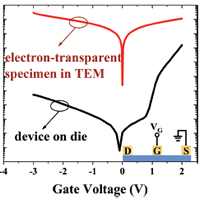
Realtime observation of "spring fracture" like AlGaN/GaN HEMT failure under bias
Zhu, Qing; Wang, Zhenni; Wei, Yuxiang; Yang, Ling; Lu, Xiaoli; Zhu, Jiejie; Zhong, Peng; Lei, Yimin; Ma, Xiaohua
Sci China Inf Sci, 2024, 67(1): 114401
The AlGaN/GaN HEMTs have been considered promising candidates for high-frequency and high-power applications, while the reliability issues greatly limit the commercialization of AlGaN/GaN HEMTs. In the past, the research on the reliability of devices was often based on Raman spectroscopy, cathodoluminescence, and TEM after failure of the devices, which is often considered to be the laborious and complicated “archaeological” kind of analysis. For TEM in particular, this analytical approach does not realize the true potential of TEM for failure characterization. In recent years, researchers have gradually adopted in-situ TEM to investigate the reliability issues, because in-situ TEM can establish a direct connection between the degradation of device electrical property and the damage of material microstructure in real time, which is very helpful to identify the failure location and mechanisms. In-situ TEM research on thin films or nanowires has been carried out, while there is little research on transistors. In 2017, Wang et al. analyzed the real-time failure process of GaN thin film by in-situ TEM. However, the in-situ TEM research on AlGaN/GaN HEMTs is challenging, due to the high requirements and difficulty of in-situ device preparation (machining accuracy, electrode connection at the nanoscale, electrostatic protection, etc.).